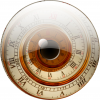Hope this is helpful:
1.) Draw your basic shapes.
2.a) Use snap-to-object, and create an linear fill using the settings in step 2.b.
2.b) Make sure you use TINTS of a named color (see the Help file about Named Colors). Here are the %values I used.
3. Fill the face of the end ellipses. Use fill principle similar to that described in step 2 (you want to play with the % values and the angle of the fill).
4.a) "Hole" of the end ellipse. Same idea as step 3.
4.b) Klone 4.a. and give it a FLAT fill using the same named color you used in 2.b. Then give it a linear stained-glass transparency.
4.c) Center align the ellipses 4.a and 4.b. Ellipse 4.b. needs to be ABOVE the ellipse 4.a.
5. Using snap-to-object, align all the parts (I often remove their outlines as their fills now define their edges).
[This message was edited by John Clements on May 02, 2001 at 11:18 AM.]



 Reply With Quote
Reply With Quote




Bookmarks